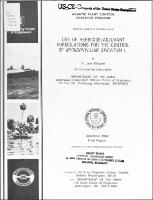Please use this identifier to cite or link to this item:
https://hdl.handle.net/11681/6224Full metadata record
| DC Field | Value | Language |
|---|---|---|
| dc.contributor.author | Killgore, K. Jack | en_US |
| dc.creator | Aquatic Plant Control Research Program (U.S.) | en_US |
| dc.creator | Environmental Laboratory (U.S.) | en_US |
| dc.date.accessioned | 2016-03-23T19:47:24Z | en_US |
| dc.date.available | 2016-03-23T19:47:24Z | en_US |
| dc.date.issued | 1984-12 | en_US |
| dc.identifier.govdoc | Miscellaneous Paper A-84-8 | en_US |
| dc.identifier.uri | http://hdl.handle.net/11681/6224 | en_US |
| dc.description | Miscellaneous Paper | en_US |
| dc.description.abstract | Adjuvants (i.e. polymers, inverting oils, attaclay granules, controlled-release granules) were used in conjunction with the herbicides 2,4-D, diquat, and/or endothall to evaluate their effectiveness for the control of Myriophyllum spicatum L. in the Okanogan River and Lake Osoyoos, Wash. The formulations which reduced sparse to moderately dense M. spicatum colonies by over 15 percent in Lake Osoyoos were 2,4-D/attaclay granular (Aqua-Kleen) applied at 20 kg acid equivalent (a.e.) 2,4-D/ha (1.2 mg/l), and 2,4-D/polymer applied at 33 kg a.e. 2,4-D/ha (1.8 mg/l). The 2,4-D applied at a rate of 34 kg a.e. 2,4-D/ha (1.2-1.4 mg/l) and used with both a polymer and an invert reduced dense M. spicatum colonies (i.e. >300 g/m² dry weight) by less than 40 percent in Lake Osoyoos; the primary reason was rapid growth of the underlying biomass. A diquat/polymer formulation applied at a rate of 27 kg a.e. diquat cation/ha (1.0 mg/l) resulted in a 90-percent reduction of a dense M. spicatum colony (i.e. >300 g/m² dry weight). Endothall used with and without polymers and inverts did not effectively control (i.e., 0- to 65-percent reduction) moderately dense to dense M. spicatwn colonies in the lake at application rates varying from 10 to 40 kg a.e. endothall/ha (0.5 to 1.6 mg/l). Regrowth was evident in these plots. Two controlled-release formulations designed to release low amounts of 2,4-D into the water for an extended time resulted in a 16- to 67-percent reduction of moderately dense to dense M. spicatum colonies. The 2,4-D/attaclay granular and the 2,4-D/polymer were applied to dense M. spicatwn colonies at a rate of 45 kg (a.e.)/ha in flowing water (9 to 15 ems) resulting in a 78-to 80-percent reduction of the treated plants (results of the 2,4-D/attaclay granular may be biased due to interplot contamination). A 2,4-D/invert formulation applied to a dense M. spicatum colony in flowing water (i.e. 9 cms) at a rate of 12 kg a.e./ha resulted in a 40-percent reduction in the treated colony. Persistence of waterborne herbicide residue ranged from 2 hr in flowing water to 2 weeks in nonflowing water. All waterborne herbicide residues were below 0.1 mg/l 24 hr after treatment. Dispersal of the herbicide was evident in all river treatment plots. The invert formulations provided a higher and more sustained herbicide level on the M. spicatum plants than the granular or polymer formulations (i.e. 540 μg/l 2,4-D in the invert plot M. spicatum plants 32 days posttreatment). Some 2,4-D was detected in the sediment up to 32 days in the 2,4-D/attaclay granular plot while the 2,4-D in the polymer and invert plots persisted for only 8 days. No changes in water quality were observed in response to treatment. However, water velocity was reduced by over 50 percent in the dense M. spicatum colonies relative to the velocity outside the colony. | en_US |
| dc.description.sponsorship | United States. Army. Corps of Engineers. Seattle District | en_US |
| dc.description.sponsorship | Aquatic Plant Control Research Program (U.S.) | en_US |
| dc.description.sponsorship | United States. Army. Corps of Engineers | en_US |
| dc.description.tableofcontents | Preface............................1 List of Figures............................3 Part I: Introduction............................4 Background............................4 Purpose and Scope............................5 Objectives............................5 Study Approach............................5 Part II: Site Description............................6 Description of Study Site............................6 Phenology and Growth Characteristics of M. spicatum............................7 Aquatic Plant Community............................7 Part III: Methods and Materials............................9 Herbicide Formulations............................9 Test Plot Establishment............................10 Data Collection Techniques............................10 Data Analysis............................12 Part IV: Results............................14 1980............................14 1981............................15 1982............................18 Part V: Discussion............................26 Still Water Applications............................26 Moving Water Applications............................29 Part VI: Conclusions and Recommendations............................31 Conclusions............................31 Recommendations............................32 References............................34 Tables 1-17 Appendix A: Water Quality Measurements............................A1 Appendix B: Herbicide Analysis Techniques and Recovery Rates............................B1 Appendix C: Linear Correlation and Percent Moisture for Selected Aquatic Plants Sampled in 1980............................C1 | en_US |
| dc.format.extent | 67 pages/2.81 MB | en_US |
| dc.format.medium | en_US | |
| dc.language.iso | en_US | en_US |
| dc.publisher | U.S. Army Engineer Waterways Experiment Station | en_US |
| dc.relation | http://acwc.sdp.sirsi.net/client/en_US/search/asset/1044166 | en_US |
| dc.relation.ispartofseries | Miscellaneous Paper (Aquatic Plant Control Research Program (U.S.)) ; no.Miscellaneous Paper A-84-8 | en_US |
| dc.rights | Approved for public release; distribution is unlimited | en_US |
| dc.source | This Digital Resource was created from scans of the Print Resource | en_US |
| dc.subject | Adjuvants | en_US |
| dc.subject | Herbicides | en_US |
| dc.subject | Polymers | en_US |
| dc.subject | Biomass | en_US |
| dc.subject | Inverts | en_US |
| dc.subject | Residue | en_US |
| dc.subject | Effectiveness | en_US |
| dc.subject | Myriophyllum spicatum | en_US |
| dc.subject | Eurasian watermilfoil | en_US |
| dc.subject | Water quality | en_US |
| dc.subject | Flowing water | en_US |
| dc.subject | Plant height | en_US |
| dc.subject | Aquatic plant control | en_US |
| dc.subject | Aquatic Plant Control Research Program (U.S.) | en_US |
| dc.title | Use of herbicide/adjuvant formulations for the control of Myriophyllum spicatum L. | en_US |
| dc.type | Report | en_US |
| Appears in Collections: | Miscellaneous Paper | |
Files in This Item:
| File | Description | Size | Format | |
|---|---|---|---|---|
| MP-A-84-8.pdf | Miscellaneous Paper A-84-8 | 2.81 MB | Adobe PDF |  View/Open |